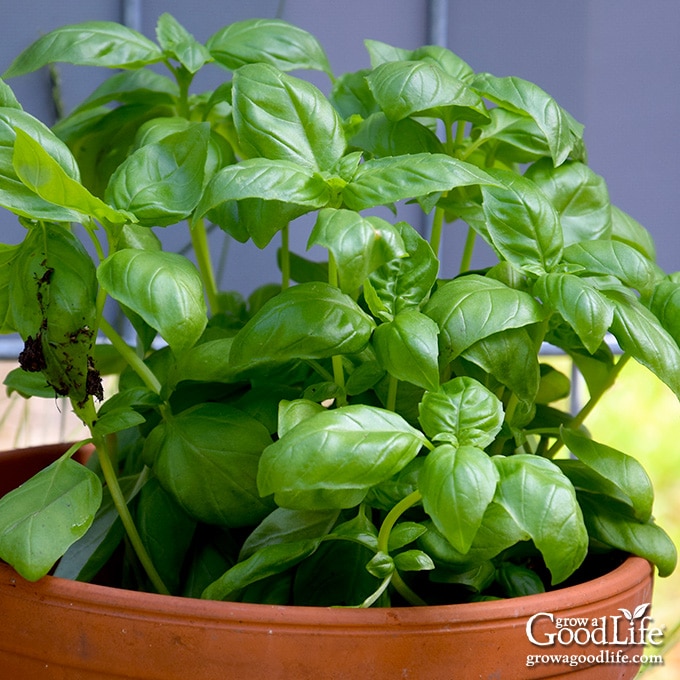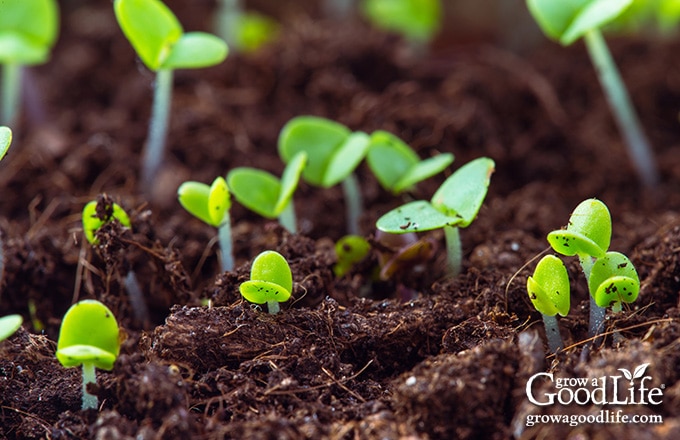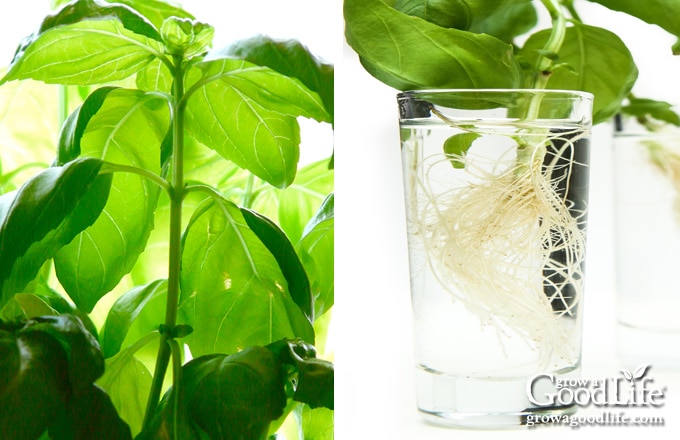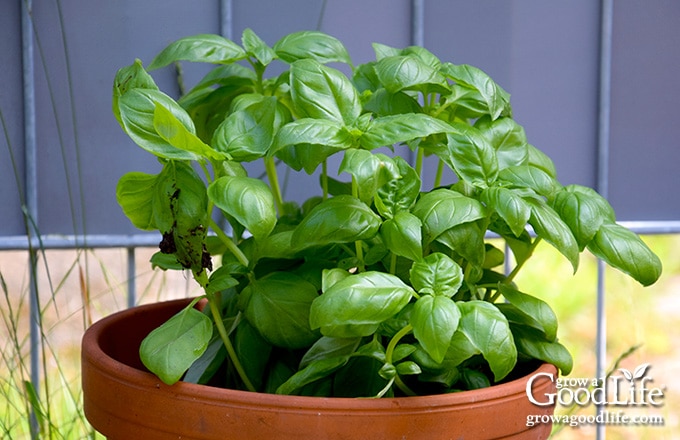How to Grow Basil
This post may contain affiliate links, which means that I may receive a commission if you make a purchase using these links. As an Amazon Associate I earn from qualifying purchases.
Basil is a tender annual herb that is easy to grow indoors on a sunny windowsill, outside in the garden, or in containers on your patio. Learn how to grow basil with these tips.

If you love the taste of fresh basil but hate paying for it at the store, then this guide is for you.
Basil is one of the most popular herbs and is easy to grow. This herb adds lots of flavor to recipes and makes an ideal companion plant for many garden vegetables.
With a little bit of care, you can have fresh basil year-round. Use these tips to grow basil and prepare for a fragrant and colorful harvest of this beautiful culinary herb.
About Basil
Basil (Ocimum basilicum) is an annual herb in the same botanical family as mint. It grows in attractive bushy plants with aromatic leaves that flavor foods. Basil is most commonly used in Italian recipes and made into pesto.
Basil is an annual herb that grows as an attractive bushy plant. This herb not only adds lots of flavor to recipes, but also makes an ideal companion plant for many garden vegetables. Use these tips for growing basil and get ready for a fragrant and colorful harvest of this wonderful culinary herb.
Types of Basil to Consider Growing
Basil is an interesting plant with many colors and flavor profiles ranging from sweet to spicy. These are a few of the most common basil varieties:
Italian Genovese Basil, also called Sweet Basil, is one of the most popular varieties for culinary use. It has a sweet and delicate flavor that blends well with tomato dishes and pesto. Genovese basil grows in an attractive, bushy, upright plant about 18-inches tall and 16-inches wide. The foliage is broad, smooth, and shiny with an intense flavor.

Purple Basils are not only flavorful but add a beautiful contrast of color to the garden. There are numerous varieties of purple basil. Depending on the type, purple basil grows up to 24 inches high and bushes out to about 24-inches wide.
- Deep Purple Basil is a striking plant with deep purple leaves and a sweet basil flavor.
- Prospera Red has reddish-purple leaves with slightly ruffled edges.
- Purple Dark Opal features purple stems and deep red-purple glossy leaves similar to Genovese basil.
- Red Rubin Basil is a compact plant with reddish-purple foliage that has an intense, spicy flavor. The foliage has a bold flavor with a slight anise or clove-like essence.

Spicy Globe Basil, also known as Greek Basil, has all the flavor of Genovese basil but grows in a compact, bushy mound to about 8-inches. Its foliage is small, thin, and strongly scented. The plant is ideal for growing in containers indoors.

Lemon Basil produces the flavor and aroma of lemon and pairs well with fish and poultry dishes, beverages, and desserts.
Lime basil has a tangy lime flavor and is a great companion to lemon basil. Use for sauces, beverages, and desserts.
Cinnamon Basil is an attractive garden plant with reddish-purple stems and stalks with pink flowers. The spicy cinnamon essence works well in desserts and Asian recipes. Cinnamon basil grows bushy, upright, tall stems reaching 30-inches high and 18-inches wide. The leaves are dark green, slightly tapered at the tip, and have a cinnamon fragrance and flavor.
Holy Basil a sweet-spicy flavor and musky scent. It’s bitter when eaten raw but is perfect for Indian recipes.
Cardinal Basil is a tall, stately plant with red blossoms that you can use in cut flower arrangements or enhance the flavor of recipes. The scent and taste are bold, so a little goes a long way.
Tips for Growing Basil
Basil is easy to grow indoors on a sunny windowsill, in the garden, or in containers on your patio.
Basil loves the summer heat and is extremely sensitive to cold. So wait until the soil warms and all danger of frost is past before growing outdoors.
You can start basil from seeds indoors or outside, purchase transplants from the garden center, or try rooting cuttings in water for an earlier harvest. Check out these tips for growing basil:
Select and Prepare Your Growing Area
Grow basil in full sun or in an area that receives at least 6 hours of sunlight daily. Basil prefers well-drained soil rich in organic matter.
Basil is a great companion plant. It is also known for repelling certain pests, making it a valuable addition to any garden. When planning your vegetable garden layout, consider interplanting basil with other crops.
Tomatoes and basil make ideal companion plants, and each will enhance the flavor of the other. Eggplant, potatoes, and bell peppers will also benefit from having basil planted near them in the garden. In addition, if you let the plants bloom, the flowers attract butterflies, wasps, bees, and other pollinators to your garden.
Prepare the garden beds by removing weeds and adding several inches of finished compost to nourish the soil to help improve drainage and aeration.
How to Grow Basil from Seed
You can start basil from seeds indoors 6 to 8 weeks before your last predicted frost date (look this up here: PlantMaps.com). Or direct sow seeds in the garden several weeks after your last frost.
To start basil seeds indoors, fill seedling containers with damp, good-quality potting soil. Plant a pinch of seeds 1/4-inch deep in the center. Lightly cover with potting soil and moisten with warm water from a spray bottle.
Cover the tray with a humidity dome, place it in a warm location, and keep the soil moist. Seeds will germinate in 7 to 10 days. You can learn more about starting seeds indoors under grow lights in this article: 10 Steps to Starting Seedlings Indoors.

Keep basil indoors until all danger of frost is past and nighttime temperatures have warmed to at least 55˚F. Then begin hardening off the seedlings by placing them outdoors in a sheltered location for 1 to 2 weeks. Finally, transplant hardened-off seedlings to a larger container or plant in the garden after all danger of frost is past.
When direct sowing seeds in the garden, remove weeds, work in several inches of finished compost, and rake smooth. Scatter the basil seeds on top of the ground, then cover with 1/4 inch potting mix and water well. Water frequently to keep the soil evenly moist. Thin the plants after germination to about 12 to 18 inches apart.
How to Propagate Basil from Cuttings
Basil cuttings are easy to root in a glass of water. Snip off a 4-inch stem of the basil plant, remove the bottom leaves, and place in water. Position the glass in a sunny window and change the water every 3 days.
You should see white roots sprouting from the stem within a week. Purple basil takes a little longer to grow roots than green basil.
Transplant the basil into a pot once the roots are several inches long. Water frequently until the plant becomes established and begins to grow new foliage.

Growing Basil in Containers
Basil is an attractive and fragrant herb plant that grows well in containers. Select a pot large enough to contain the plant and give the roots room to grow, with plenty of holes for drainage. Use good quality potting mix and soak the soil for several hours to hydrate. Then fill the pot and transplant your basil. Firm the soil gently to remove air pockets and water well.
Place the containers in the shade or filtered sunlight for several days, then move them to a sunny location where they will receive at least 6 hours of sun daily.

Grow Basil Indoors
Basil grows best in a warm area away from drafts that receives at least 6 hours of sun each day. Grow basil in 10 to 12-inch containers filled with an all-purpose soilless potting mix. Expect your indoor basil plants to produce for several weeks before the stems get woody. To ensure a steady supply of basil, plant a new batch of seeds every few weeks or sprout root cuttings in water and pot up when the roots develop. Learn more about growing herbs indoors in this article: How to Grow an Indoor Herb Garden.
How to Care for the Plants
Besides frequent harvesting, basil doesn’t need much care, but here are some tips to keep the plants healthy and thriving:
- Watering: Basil prefers evenly moist but not wet soil. Water once or twice a week when the soil surface feels dry.
- Fertilizing: Feed basil once in spring and again in mid-summer with your favorite type of all-purpose plant food. Container plants will need additional nourishment. Feed with a water-soluble organic fertilizer, such as fish emulsion, every 2 weeks during the growing season.
- Pruning: Harvest and prune the basil frequently to promote new bushy growth. Cut the stem about 1/4-inch above a set of leaves, and the plant will grow two new branches.
- Weeding: Remove weeds frequently, so they do not compete with the plants for water and nutrients.
- Mulching: In the garden, add a layer of organic mulch, such as straw or shredded leaves, around the plants to keep the roots cool and conserve moisture.
How to Keep a Basil Plant from Flowering
Once the plants start flowing, the taste of the leaves turns bitter. You can prevent the basil from producing unwanted flowers by pinching off the flower buds as they appear. Regular harvesting and pruning will stop the flower buds from developing but check the plants every few days. Pinch off any buds you see forming.

Watch for Pests and Diseases
Japanese beetles, slugs, aphids, and leafhoppers are the typical pests that bother basil. Handpick the larger pests off the plants and blast them with water from a water hose to remove smaller pests.
Downy mildew, black leaf spot, fusarium wilt, and root rot are the common diseases of basil, usually caused by too much moisture. Once affected, no treatment will restore the basil back to health. So instead, pull the plants, place them in the trash so as not to spread spores, and start new basil seeds in a clean area.
How to Harvest Basil
The best time to harvest basil is in the morning after the dew has dried and before the hot sun hits the plant.
Harvest by cutting the stems with scissors about 1/4-inch above a set of leaves, and the plant will grow two new branches. Prune frequently to keep the plant producing and prevent flowers from blooming.

How to Preserve Basil
Unlike most herbs, basil doesn’t have much flavor when dried. My favorite way to preserve basil is to chop, combine with olive oil, and freeze it flat in small zipper bags. The oil helps prevent the basil from browning, and freezing it flat makes it easy to snap off pieces as needed for cooking.
Add basil leaves to the bowl of a food processor. Turn it on and drizzle in extra virgin olive oil and blend until the basil is chopped and coated evenly in oil. Place the basil into quart-sized freezer bags, squeeze out the air, flatten it out evenly, and label and freeze.
To make pesto, thaw out the basil base briefly, and then blend in a food processor with garlic, Parmesan cheese, walnuts or pine nuts, salt and pepper, and extra olive oil if needed.
—
Basil is an attractive and versatile herb both in the garden and kitchen. I hope these tips for growing basil help you to enjoy a delicious and colorful harvest of this amazing culinary herb.
You May Also Like the Following:
Good planning is key to a successful vegetable garden
Whether you are new to growing your own food or have been growing a vegetable garden for years, you will benefit from some planning each year. You will find everything you need to organize and plan your vegetable garden in my PDF eBook, Grow a Good Life Guide to Planning Your Vegetable Garden.

